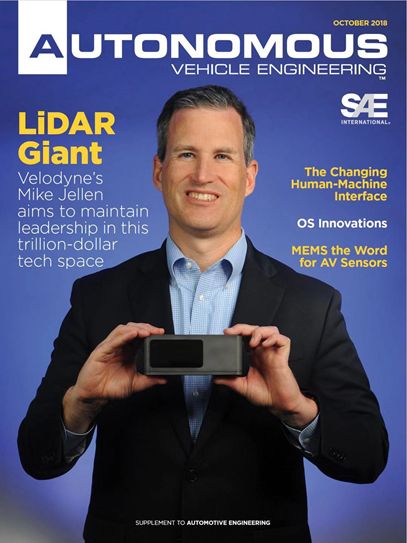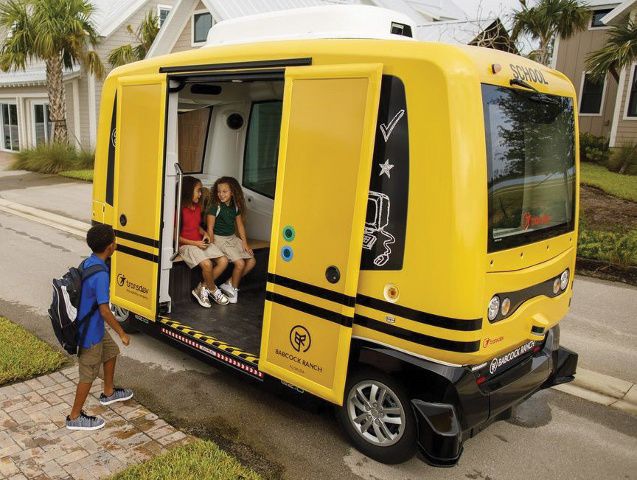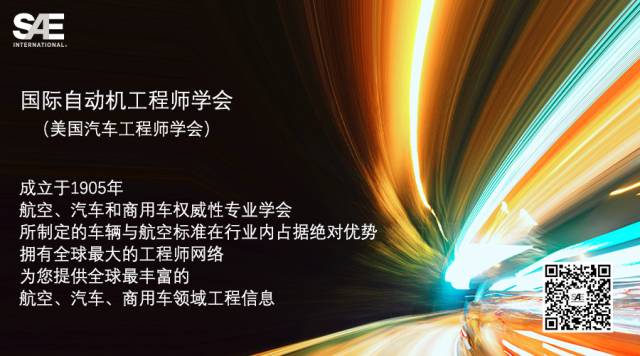
 Velodyne 公司最高端的 3D 激光雷达传感器VLS-128 发布于 2018 年,专为自动驾驶汽车设计,拥有128 个激光通道,可提供正负 0.1 度的水平/垂直分辨率,探测范围 300 米,视场角度可达 360 度。图为 VLS-128 生成的街景点云图,速度达每秒 960 万点。
Velodyne 公司最高端的 3D 激光雷达传感器VLS-128 发布于 2018 年,专为自动驾驶汽车设计,拥有128 个激光通道,可提供正负 0.1 度的水平/垂直分辨率,探测范围 300 米,视场角度可达 360 度。图为 VLS-128 生成的街景点云图,速度达每秒 960 万点。 Velodyne 最新激光雷达产品的尺寸对比图,从左到右分别为 VLS-128、32 通道的 Ultra Puck VLP-32C 及外形最为紧凑的固定式激光雷达阵列 Velarray。此外,在本期杂志封面上,Velodyne 公司激光雷达业务总裁 Mike Jellen 手中握着的正是一款 Velarray 。
Velodyne 最新激光雷达产品的尺寸对比图,从左到右分别为 VLS-128、32 通道的 Ultra Puck VLP-32C 及外形最为紧凑的固定式激光雷达阵列 Velarray。此外,在本期杂志封面上,Velodyne 公司激光雷达业务总裁 Mike Jellen 手中握着的正是一款 Velarray 。 对于商用自动驾驶穿梭巴士(比如图中来自 EasyShare 的EZ10)而言,激光雷达的集成“隐身”挑战并不像私家车般显著,但巴士运营商仍然希望激光雷达能够无缝融入车辆,不影响其外观。最近,法国自动驾驶汽车制造商EasyShare 在美国加州的部分公共路段推出了自动驾驶汽车穿梭巴士服务。
对于商用自动驾驶穿梭巴士(比如图中来自 EasyShare 的EZ10)而言,激光雷达的集成“隐身”挑战并不像私家车般显著,但巴士运营商仍然希望激光雷达能够无缝融入车辆,不影响其外观。最近,法国自动驾驶汽车制造商EasyShare 在美国加州的部分公共路段推出了自动驾驶汽车穿梭巴士服务。 福特的 Fusion 自动驾驶演示车将传感器阵列安装在车辆顶部两侧的“支架”上,并在车辆A 柱上安装了 Velodyne 的 Ultra Puck 激光雷达。
福特的 Fusion 自动驾驶演示车将传感器阵列安装在车辆顶部两侧的“支架”上,并在车辆A 柱上安装了 Velodyne 的 Ultra Puck 激光雷达。
目前,激光雷达市场正处于高速发展之中,市场规模可达数万亿美元。尽管,这个市场中有超过100家竞争对手都在虎视眈眈,但行业领袖 Velodyne 公司总裁Mike Jellen 并不打算将领先优势拱手让人。
如果谈起“激光雷达”,你脑海中浮现的第一家公司是哪家?可能很多人的第一反应都是Velodyne,毕竟这家硅谷公司的开创性激光雷达 HDL-64(64 通道、360° 视场)在 2007年 DARPA 无人驾驶汽车城市挑战赛中“一战成名”的表现太过让人印象深刻。如今,Velodyne 继续致力于 3D 激光探测与测距传感器的研发,目前有 7 款激光雷达传感器产品已正式上市,抵达成百上千家移动出行行业客户,进行测试或有限商用。目前,Velodyne 公司圣何塞工厂的年产量已达数万台,但相比于未来市场对激光雷达产品的巨大需求,这仍然只不过是沧海一粟。
“通过一段时间的密集车队测试,我们现在正在快速扩大汽车级激光雷达产品的量产规模,同时面向零售型 ADAS 系统和按需提供式移动出行服务车队。”Velodyne 公司激光雷达业务总裁、首席商业官 Mike Jellen 解释道,“目前,我们的产品大多供应给 SAE 4 级自动驾驶车辆,主要用于研发。然而,ADAS 安全系统也将在未来的新车活动中占据一定比例。我们认为,激光雷达产品的销量将在 2019 到 2025 年间实现持续增长。”
对 Velodyne 而言,虽然激光雷达的高清 3D 绘图能力也可以为公司创造收益,但自主和自动驾驶汽车仍是激光雷达产品的主要市场,一个价值数万亿美元的庞大市场。”Jellen 告诉SAE《自动驾驶汽车工程》杂志,“我们预计,世界上将有十亿汽车装配激光雷达,平均每辆车安装 2 到 4 部,也就是说每辆车在传感器方面的成本在 1,000 美元左右,那整个市场的规模可以轻松达到数万亿美元。”
事实上,Velodyne 的估计还算保守。Aptiv 公司已经在自己一款基于 BMW 的自动驾驶技术演示车上安装了 9 部激光雷达。
为了为即将到来的淘金热做好准备,Velodyne 一直在稳步扩充公司的研发、科学和技术力量。作为一家2006 年成立的公司,目前,Velodyne 在全球共有 5 个工厂和超过 500 名全职员工。
目前,Velodyne 已经拿到了多家投资者的投资,其中最引人注目的投资方包括美国福特(Ford)和中国百度公司。此外,Velodyne 与梅赛德斯奔驰(Mercedes)也有合作。
这家公司的核心知识产品资产包括嵌入式软件和算法、探测器及 ASIC(专为移动出行级激光雷达定制的专用集成电路)技术。值得一提的是,Velodyne 公司的这些知识产品资产全部由公司内部研发。
提高分辨率、降低成本
2018 年 CES 拉斯维加斯消费电子展中,大量创新激光雷达产品都大放异彩,而且很多已经进入客户评估阶段,其中就包括Velodyne 公司的最新 VLS-128 激光雷达产品。Velodyne 公司激光雷达业务总裁 Jellen 称 VLS-128 为“世界上最好的激光雷达传感器”,这款产品现已从公司曾在 DARPA 挑战赛中“一战成名”的经典 HDL-64 激光雷达中接过大旗,登陆了多家厂商的自动驾驶原型车。据了解,VLS-128相较其之前型号,体积和重量均小了三分之一,激光通道数量却增加了一倍,视场仍然为 360 度,据称可以提供比之前高 10 倍的分辨率,物体识别和探测性能都有了显著改善。
Velodyne 公司称,VLS-128的探测距离高达 300 米(984 英尺),可直接用于车辆的目标探测,无需搭配额外的传感器。此外,该产品专为自动组装而设计,采用了专有的激光对准工艺。
除了 VLS-128之外,Velodyne 公司还推出了一款探测距离在 200 米(656 英尺)的固定式激光传感器 Velarray。作为一款外形紧凑的激光雷达产品,Velarray 在汽车车身中的无缝集成将更加容易,同时适用于一些具备 ADAS 功能的 SAE 2 级部分自动驾驶汽车,以及 SAE 4 级或 SAE 5 级全自动驾驶汽车。除了显著的集成优势,Velarray 的价格也同样具有吸引力,仅为“数百美元”。
Jellen 表示,公司还在同时研发将激光雷达与其他类型的传感器(包括摄像头)集成在一起的“集成传感阵列”,同时迎合终端用户的直接使用需求和其他公司的内部研发需求。
Velodyne 计划采用分布式全球生产战略,公司的生产设施分布在北美、中国和欧洲等地区,可直接支持当地客户的需求,并提供多款汽车激光雷达产品,满足不同市场的多样化使用场景。
“在全自动驾驶汽车方面,一些行业巨头肯定会先自己来做整合工作,其他公司则更有可能通过一些一级供应商合作伙伴,获得 Velodyne 的支持。”Jellen 表示,“对于 ADAS 安全市场,我们可以通过一级供应商合作伙伴提供支持,也可以直接提供面向终端用户的完整解决方案。因此,我们将采用一种一级/二级供应商混合交叉合作的策略,如今的情况就是这样。“
SAE 4级自动驾驶汽车市场:普及率将达到 100%
目前,激光雷达市场正处于高速发展之中,市场规模可达数万亿美元,Velodyne 占据绝对优势。但与此同时,该市场中还有超过100 家蠢蠢欲动地竞争对手,其中也包括一些 Velodyne 前员工创立的公司。在这样一个高速增长的市场中,这种“摘樱桃”(Cherry-picking)现象非常常见。
“这是一个潜力巨大的行业,一定会有大量公司前仆后继地冲入这个领域,这并不令人惊奇。”Jellen表示,“不同公司在不同时段会采用不同的解决方案,尽管其中有些可能已经有 30 年或 40 年的历史了。其中,一些公司正在借激光雷达的东风进行炒作,并希望从大量流入该领域的资金中分一杯羹。”
自动驾驶汽车工程师普遍认为,激光雷达对于 SAE 4 级和 5 级全自动驾驶汽车绝对必不可少,在 SAE 3 级自动驾驶汽车中也具有很高的价值。激光雷达可以利用脉冲激光测量动态距离,创建并更新 3D 地图,让 3 厘米级别的车辆定位成为可能,还可以作为一种安全失效冗余系统。
高清地图允许车载处理器“不间断地进行比较,感知固定和移动物体的位置,并获得车辆在空间中的确切位置,无关于车辆的 GPS 或 IMU 惯性测量单元的性能。”Jellen 表示“这极大地简化了车辆的实时感知挑战。”
Jellen 是一名电气和软件工程师,他在 2015 年加入 Velodyne 公司,拥有 20 年的机器人和自动化行业经验。Jellen 认为,激光雷达的真正商业应用将首先出现在自动驾驶穿梭巴士等在地理围栏中行驶的运输车辆。目前,试点车队的测试正在顺利进行中。
Jellen 表示,“未来,Navya、EsayMile 和百度Apollo (最近刚刚在中国公布的穿梭巴士项目)等自动驾驶穿梭大巴公司将继续取得季度增长。”
Jellen 预计,在零售汽车市场中,激光雷达在 SAE 4 级自动驾驶汽车中将逐步实现 100% 的普及。他断言,“我认为,除了激光雷达,没有其他任何类型的传感器可以满足 SAE 4 级自动驾驶汽车的需求。”此外,一些提供“真正 SAE 3 级自动驾驶系统”(即高速公路下的放手/放松系统)的公司也开始为旗下产品增加激光雷达系统,从而提供一些 SAE 4 级自动驾驶功能,而不是依赖于驾驶员充当系统的“后备队员”。
成本、尺寸、功耗
目前,激光雷达市场中的初创公司数量正在以爆发性速度增长,通常可以按照特定的传感器类型对相关公司进行分类,例如固态激光雷达公司。Jellen 表示,除了现有产品外,公司还在研究数十种采用不同激光光束控制方法(包括固态传感器)和不同视场范围的激光雷达产品,从而更好地满足不同使用场景的要求。Jellen 解释到,“我们希望为特定应用场景选择最合适地特定产品。”
通常来说,激光雷达的视场范围可以分为两类:窄视场和宽视场。窄视场激光雷达的视场范围通常为 120 度或更小;宽视场激光雷达的视场则为 180° 或更大。 对于车辆安装的固定式传感器来说,清晰、宽广的180 度视线范围有助于车辆应对一些更令人生畏的驾驶场景,例如在高速接近丁字路口时,及时识别道路中的黑色轮胎碎片。
车辆研发工程师告诉《自动驾驶汽车工程》,2018 年,降低单位成本和提升包装效率(将激光雷达“无痕”集成至车辆外壳内)是激光雷达领域需要解决的两大挑战。Jellen 表示,提高激光雷达的成本效益离不开两件事:提高产量、借助 ASIC 技术。目前,Velodyne 公司的“基本款”16 通道 VLP-16 Puck 激光雷达的探测距离为 100 米,2018 年的小批量订单价格约为 4,000 美元,而且可以为采购量大的汽车用户提供更有竞争力的价格,而较早型号 HDL-64 的售价则高达 70,000 美元。
Jellen 预计,车辆安装 4 部激光雷达的成本大约在 1,000 美元,这实际反映了 Velodyne 公司激进的降低成本计划。事实上,除了提升产品性能、提高封装效率外,Velarray 传感器(采用 ASIC 技术)的另一项主要任务就是降低成本。第一代 Velarray 激光雷达的尺寸为 125 x 50 x 55 mm(大约 5 x 2 x 2 英寸),对于 OEM 设计师和车辆集成团队来说,将这种尺寸的激光雷达集成至车辆外壳种会更容易。
一位车身结构工程师告诉《自动驾驶汽车工程》:“邮政车或自动驾驶出租车完全可以将激光雷达封装在车身四周的突起中,但私家车却不行。”Jellen 解释说,“传感器安装地越高,你的视线就更高、可靠性也更高。对于一些具备自动紧急制动和 SAE 2 级以上自动驾驶功能的零售车辆来说,可以考虑将传感器安装在车辆保险杠中。”
但是,为了实现真正的 SAE 3 级自动驾驶功能(放手/放松驾驶,也就是驾驶员既不需要操作,也不需要操心),“你必须把传感器至少安装在驾驶员视线的高度才能让传感器有效‘观察’周边环境。”
Velodyne 的 ASIC 技术还有助工程师更好地管理“耗电大户 ADAS 传感器阵列”。“ASIC技术可以实现实时逻辑与‘智能’,且功耗非常低。”Jellen 解释道,“未来,Velodyne 的传感器将变得更加智能化,可以分担如今自动驾驶汽车主机系统的部分工作。我们都知道,主机系统的耗电量一直很大,如果我们的传感器可以分担部分工作,则主机的功耗也能降下来一些。”
为了实现这一目标,Jellen 称 Velodyne激光雷达可以实现“同时定位与制图”且耗电量甚至不到 1 瓦。介绍一下,“同时定位和制图”是指传感器在感知周边环境时,同时将周边环境的结构绘制下来,这时一项非常了不起的成就。
Jellen 表示,“这有助于降低功耗,及集成复杂系统的成本。很显然,这非常符合行业的要求和目标。”
关键任务技术
目前,为了在公司快速增长的团队中增加研发力量,Velodyne 正在积极开展校园招聘和社会招聘活动。Jellen 表示,“我们正在寻找各个领域中的优秀工程师,包括电子电气、嵌入式软件、光学工程、包装和质量等。”他同时承认,3D 激光雷达是一个非常新的专业,因此“我们也在寻找一些具有激光和光学行业经验的人才。”
随着 Velodyne 公司不断发展,公司管理层认为,保持公司创始人David Hall 不断创新的企业家精神和灵活机动的公司战略非常重要。当然,说起来总比做起来容易。
“据报道称,美国每 5 秒中就发生一起车祸,中国每天有 500 人在车祸中丧生,这太疯狂了。”Jellen 表示,“我们必须团结一致,尽快让传感器在新车中发挥作用,让这项可以挽救生命的技术尽快造福于大众。”
100 competitors want to eat his lunch, but Velodyne president Mike Jellen aims to maintain leadership in this fast-moving, trillion-dollar technology space.
In a word-association game that begins with “lidar companies,” the first response is likely to be “Velodyne.” The Silicon Valley-based pioneer in 3D light-detection-and-ranging sensors, whose groundbreaking 64-laser, 360° field-of-view technology famously helped win the 2007 DARPA Urban Challenge for self-driving vehicles, is currently shipping seven sensor models to hundreds of mobility-industry customers for testing and for limited commercial use. The annual production rate from the company’s San Jose plant today, in tens-of-thousands of units, is just the tip of an impending tidal wave.
“We’re moving fast through a period of intense fleet testing into the initial ramp-ups for true auto-motive-scale, high-volume production—both for the retail ADAS as well as for on-demand mobility fleets,” explains Mike Jellen, Velodyne Lidar’s president and chief commercial officer. “Most current volume goes into [SAE] Level 4 developments. A significant portion of new-vehicle activity is on ADAS safety systems. We see an opportunity for sustained unit-volume growth occurring 2019 through 2025.”
While lidar’s high-definition 3D mapping capability represents a separate market for Velodyne, automated and autonomous vehicles (AVs) remain “the dominant force—a trillion-dollar market opportunity,” Jellen tells SAE’s Autonomous Vehicle Engineering. “We’d like each of the billion vehicles on the world’s roads to have two to four lidar sensors—maybe $1000 of sensors per vehicle—and see the trillion-dollar opportunity emerge.”
OEMs may bring suppliers even greater delight: Aptiv uses nine lidar units in its BMW-based AV demonstration vehicle.
To prepare for the gold rush, Velodyne Lidar has been steadily growing its engineering, scientific and technical resources. The company, founded by CEO David Hall in 2006 (see sidebar), now has over 500 full-time employees at five facilities around the world.
Ford and Baidu are among its high-profile investors, and the company also has a cooperation with Mercedes.
Velodyne’s core IP portfolio includes embedded software and algorithms, and detectors, as well as ASICs—application-specific integrated circuits that are custom engineered for mobility lidars. All are strategically developed in-house.
Higher resolution, lower cost
The latest fruits of this focus debuted at the 2018 CES and have been in customer evaluation. The VLS-128, which Jellen anointed “the best lidar sensor on the planet,” succeeds the company’s classic DARPA-winning HDL-64 seen spinning atop many proto-type AVs. Nearly one-third smaller and lighter than its predecessor, with twice the lasers (channels), the VLS-128 is claimed to deliver ten times better resolution. This greatly improves object identification and detection within a 360° field of view (FOV).
Velodyne claims the new lidar, with range up to 300 m (984 ft) can be used directly for object detection without additional sensor fusion. It was designed for automated assembly that includes a proprietary laser-alignment process.
Also appearing was the Velarray, a fixed-laser, solid-state sensor with 200-m (656-ft) range. Designed with a compact form factor for more natural integration into vehicle bodywork of both ADAS-enabled SAE Level 2 automated-driving vehicles, as well as SAE Level 4 and 5 autonomous vehicles, the Velarray’s target price—“in the hundreds of dollars” at automotive scale—was equally big news.
And according to Jellen, development also is underway on integrated arrays that combine lidar and other sensor modalities including camera—“both in direct fulfillment efforts to customers as well as internal R&D.”
Velodyne plans a regional approach to global lidar production, with manufacturing facilities to serve customers directly in North America, China and Europe. A range of vehicle-integration models depends on the vehicle market and use case.
“On the full-AV side, the leading companies will have in-house integration efforts,” Jellen said. “Others will rely on Tier-1 partners, through whom Velodyne will support directly. For the ADAS safety market, Velodyne will support both through Tier 1 partners as well as through direct full solutions. Therefore, we plan on a Tier 1/Tier 2 mix, as is the case today.”
100% Level 4 market penetration
Occasionally dubbed “the 800-pound gorilla” of the mobility-lidar market, Velodyne currently sits atop a burgeoning technology space that, by some counts, includes nearly 100 players of varying strengths and prospects. Some new competitors include ex-Velodyne staff—typical cherry-picking activity in a high-growth industry.
“Given the potential, it’s not surprising we see a large number of companies and approaches coming in to attempt to serve this vast opportunity,” he said. “Different companies are targeting different solutions at different times, though there has been a lot of repackaging of approaches that are 30, 40 years old. A number of these companies are taking advantage of the hype on lidar, and of the significant investment flowing into the space.”
AV engineers widely consider lidar to be an essential sensor (in combination with cameras and radars) for SAE Level 4 and 5 “full-autonomous” operation, and of high value in Level 3 automated driving. Employing a pulsed laser to measure variable distances, lidar is used for creating and updating 3D maps that enable real-time, 3-centimeter-level precision in vehicle location as well as providing fail-safe sensor redundancy.
The high-def maps allow the on-board processors to “continually compare and get a sense of static and dynamics and know exactly its position in space regardless of GPS or IMU [inertial measurement unit] performance,” Jellen said. “This greatly simplifies the real-time perception challenge.”
Jellen, an electrical and software engineer, joined Velodyne in 2015 with 20 years’ industry experience in robotics and automation. He expects the first major commercial lidar applications to be in autonomous shuttles and delivery vehicles running a geofenced route. Pilot-fleet use is well underway.
“You’ll continue to see quarter-over-quarter growth with [AV shuttle] companies such as Navya, EasyMile and Baidu Apollo,” whose new shuttle program in China was recently announced.
For the retail vehicle market, Jellen expects eventual 100% market penetration for lidar for SAE Level 4 driving. “I do not see another type of sensor that fills in for its capability,” he asserted. And companies choosing a “true Level 3” system—hands-off/mind-off highway operation—are including lidar to provide Level 4 functionality in that operating mode, rather than risk relying on the driver to be the backup.
Cost, size, power consumption
The explosion of lidar start-ups has tended to classify companies by a particular sensor approach, such as solid state. Velodyne is researching “dozens” of models beyond its current portfolio, Jellen said. The goal is to offer different beam-steering methodologies (including solid-state sensors), and both wide and narrow FOV types to serve various use cases. “The right tool with the right maturity for a given product line is how we do it,” he explained.
Narrow FOV is typically 120 degrees or less; wide is 180° or more. For one sensor placed on one location in the vehicle, being able to “see” a clear 180-degree sweep helps to solve some of the more daunting driving scenarios, such as identifying black tire-chunk debris in the road while approaching a ‘T’ intersection at speed.
Unit cost reduction and package efficiency—creating a form factor that can be integrated invisibly into a vehicle’s exterior skin—are the two greatest challenges related to lidar in 2018, vehicle development engineers tell AVE. According to Jellen, cost performance requires two things: volume, and ASICS. Velodyne’s “base” 16-channel unit, the VLP-16 Puck with 100-meter range, can be had for about $4000 for low-volume orders in 2018—far less than the $70,000 price tag of the old HDL-64 and has the ability to be priced competitively for high-volume automotive customers.
Jellen’s projection of $1000 for a four-unit vehicle array highlights Velodyne’s drive toward an aggressive unit-cost target, at volume. That is one of the missions, along with performance and package efficiency, of the new ASIC-enabled Velarray sensor. The first-gen Velarray unit measures 125 x 50 x 55 mm (roughly 5 x 2 x 2 in.), a dimension that OEM stylists and vehicle-integration teams will find easier to incorporate all around the vehicle.
“Having to package lidars inside aero-style blisters around the body may be acceptable for mail trucks or robo-taxis, but not for private vehicles,” a body-structures engineer tells AVE. Jellen explains that the challenge of perception is “you ‘see’ the environment much better, and with higher reliability, with a higher vertical sensor position within the vehicle. A retail vehicle that contemplates automatic emergency braking and limited Level 2-plus functionality may contemplate locating sensors in the bumpers.”
But in the quest for true Level 3 eyes-off, mind-off functionality, “you need the sensors to effectively ‘see’ at or above the human-eye [vertical height] level.”
Velodyne’s ASICs development also is helping engineers manage power-hungry ADAS sensor arrays. “They [ASICs] are enabling real-time logic and ‘intelligence’ at very low power consumption,” Jellen explained. “You’ll continue to see Velodyne sensors become more intelligent, with some ability to off-load the high-power host systems in the AVs today. As they off-load some of that responsibility, the power consumption required for the host will be reduced.”
Toward that goal, he cited demonstrations of ‘slamming’ within the Velodyne lidar using less than 1 watt of power. The term—simultaneous localization and mapping—refers to the algorithmic challenge of localizing (i.e. finding the position/orientation of) a sensor with respect to its surroundings, while simultaneously mapping the structure of that environment. A noteworthy achievement.
“It helps reduce power consumption and the integration costs of complex systems, which are clearly targets set by the industry,” Jellen said.
Mission-critical tech
Adding engineering muscle to the fast-expanding team, Velodyne has ongoing recruiting efforts at the major universities and within industry. “We’re looking for strong engineers across the various disciplines including electrical, embedded software, optical engineering, advanced packaging, and quality,” Jellen reports. The real 3D lidar discipline, he admits, is a fairly new space, “so we look for people with experience in the laser and optical industries.”
And as Velodyne diversifies, its leadership realizes the importance of maintaining the entrepreneurial spirit and flexibility created by founder Hall. That, of course, can be easier said than done.
“There is a police-reported vehicle accident in the U.S. every five seconds; 500 people are lost per day in China. These are crazy statistics,” Jellen says. “We need sensors that deliver true functionality into new vehicles as quickly as possible. We’re united under the mission of bringing life-saving technology to the masses.”
Author: Lindsay Brooke
Source: SAE Autonomous Vehicle Engineering Magazine
等级
打分
- 2分
- 4分
- 6分
- 8分
- 10分
平均分
